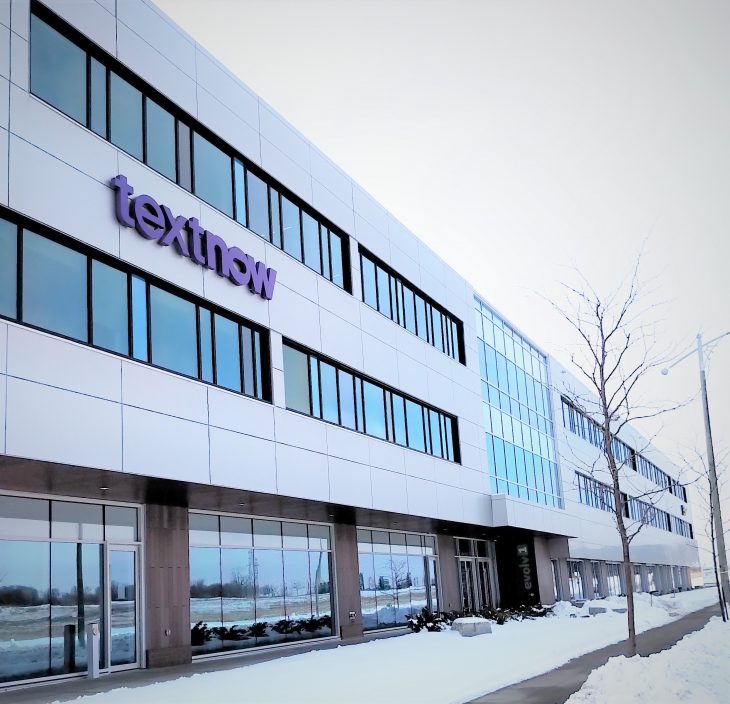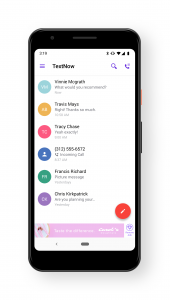
Textnow is the largest free phone provider in the United States
By Greg O’Brien
WATERLOO, Ont. – How is it that a Canadian company has seen tremendous success as a mobile virtual network operator? Simple. While they’d love to grow in Canada, the company has instead penetrated the much larger, more competitive, American market.
Waterloo’s textnow was founded in 2009 by CEO Derek Ting (not to be confused with Ting Mobile, another successful Canadian MVNO doing great business in the U.S. and is owned by Toronto’s Tucows) and Jon Lerner who wanted to see everyone have access to mobile technology at an ultra-affordable price: free.
Originally called Enflick, textnow employs more than 120 people, mostly in Waterloo but also in offices in San Francisco and Portland. Its app has been downloaded more than 200 million times and there are 14 million monthly active users on its platform. In the Google Play store, it has earned a 4.4 out of 5 rating with more than 700,000 reviews. It counted more than 5.2 billion ad impressions last month – because if you’re offering a free service, it has to be paid for somehow.
Textnow is a full phone service, in an app. However, its key difference is it also gives users a free phone number. That means it’s not like WhatsApp, for example, where those users can only talk to other WhatsAppers. Textnow customers can talk and text with anyone.
In fact, inside of two minutes, users can get their own phone number via the textnow app and immediately make calls and text for free in any Wi-Fi zone anywhere in the world.
The company’s real game-changer, however, is its brand new Free Nationwide Talk & Text service where customers can for the first time call and text for free outside of a Wi-Fi zone thanks to textnow’s MVNO agreement with Sprint. Prior to that, customers could only roam onto the Sprint network for an extra fee.
While free is its base price, customers can pay to upgrade to remove the ads (which look like many other ads found in mobile games, for example) for US$10/month or buy data, starting at US$20/month for  2GB.
2GB.
“We’ve developed a strong partnership with Sprint and showed them we can add a lot of subscribers to their network that they’re unable to otherwise add themselves to their own retail and prepaid channels,” said Tristan Huntington (pictured), senior vice-president of business development in an interview this week at the company’s new headquarters on Wes Graham Way in Waterloo (above).
“We have a lot of subscribers that just can’t pay even for prepaid phone service. They don’t have $20 a month.” – Tristan Huntington, textnow
Textnow is hitting the demographic that the big brands often have trouble reaching – low income Americans (and many Canadians, too as the textnow app works great on Wi-Fi in Canada). “We have a lot of subscribers that just can’t pay even for prepaid phone service. They don’t have $20 a month. They maybe get free Wi-Fi at Wal-Mart or Starbucks or whatever, and we give them a phone number and a way to interact with the rest of society. They can text their friends. They can get a job. They can do whatever.
“We believe everyone should have the right to a phone number and phone service. It’s something everyone needs and deserves regardless of income or age, or wherever you live,” added Huntington.
Plus, given the low income demographic textnow attracts, if a customer can’t pay, they aren’t disconnected. “With a typical carrier, say you’re on a prepaid service, you pay $20 a month but if you can’t afford $20 the next month, your phone service just cuts off… With our service… if you can’t afford your next $20 payment, you just go down to our free plan. So you keep your number, you keep your service. Maybe you go to Wi-Fi-only or maybe you go to our free cellular plan and you can’t stream YouTube, but you still have a phone service that works,” he explained.
Coming to an MVNO agreement with Sprint wasn’t very onerous, Huntington added, because U.S. carriers eagerly search of incremental revenue that maximizes their networks in ways Canadian carriers do not. “Textnow has developed this partnership with the wholesale division in Sprint where we buy wholesale access to their network and resell it to customers of ours that they can’t hit, or they don’t do a great job of attracting on their own retail brand – and then we find creative ways to sell that to customers.”
So, if it can work well with Sprint, why not in its home country? “I think in general, the industry in Canada is not as competitive,” added Huntington. “There’s more reluctance to provide lower pricing for fear of degrading networks or preventing ability to invest in more networks. In the U.S., there’s more real competition… the carriers are more in it to just grow incremental revenue wherever they can.”
While textnow chose not to take part in the CRTC’s wireless policy review hearing starting Tuesday, the MVNO is keeping a watchful eye on the proceeding, because it really would love to do business here. “We’ve had conversations with carriers in Canada. I wouldn’t say they’ve all been productive, but more recently we’ve had productive conversations, so I think things are, hopefully, moving in the right direction. Ultimately, for us it’s about just figuring out a strategy that works for everybody,” said Huntington.
“We want the carriers to have really high quality networks in Canada. We want them to roll out 5G to customers, and we feel like we can drive additional customers to carrier networks that they can’t target well today.” – Huntington
“We want the carriers to have really high-quality networks in Canada. We want them to roll out 5G to customers, and we feel like we can drive additional customers to carrier networks that they can’t target well today. That’s really where we see the value-add for them. We can provide additional traffic and growth on their network without impacting their top tier retail segments.”
When asked if the CRTC or the federal government should mandate MVNO access for companies like his, Huntington was circumspect. “We want to provide the best phone service we can to as many people as possible and I don’t know exactly what the best strategy is for making that happen – whether that’s government mandate or whether that’s carriers figuring out ways to work with partners like us.”
“We’re very committed to Canada, and we would love to be able to offer the same products and services that we offer in the U.S.,” he added.
That said, should apps like textnow be considered “facilities-based” under new rules, or should that definition be dropped altogether? ISED Minister Navdeep Bains, last June, seemed to be leaning towards considering apps or software as facilities.
“I think it’s hard to apply a terminology that’s defined in the way we looked at it in industry 50 years ago to the way it’s adapted and changed today,” responded Huntington. “So ‘facilities-based carrier’, for example, is a term that doesn’t even really make a lot of sense in today’s telecom world… Should we be called facilities-based? I don’t know.”
Since it offers phone numbers to customers, however, textnow’s business model is a little more complicated than many simpler apps. They are like a carrier in some ways. “We have to do all of these interconnections,” explained Huntington. “We have to deal with all of the underlying telecom stuff that a regular carrier has to deal with, but… in this app world… it’s hard to adapt newer technologies onto regulations that were written 20 or 30, 40 years ago. It’s a difficult job.
“I don’t envy the CRTC or whoever it is, regulators, lawmakers who have to look at that and actually try and figure out how do we move from here to there.”



